It’s my thought that organizations can make use of talented teaching artists, provided the teachers- and the organizations- have an understanding of the goals of the program, the participants’ needs, and what adaptive music means to all involved. Below, I’ll share some of the skills that are needed.
Read Moremultiple areas of the brain are involved in processing music, whether you’re performing it or engaging in it in some other way. When sound enters the ear, its vibrations against the eardrum convert to electric signals that travel (via nerves) to the brainstem, which relays messages to many parts of the brain. Different parts of the brain are activated depending on how we are engaging in the music, and what type of music it is.
Read MoreMusic therapists use a technique called entrainment, in which we match the tempo of our improvised music to the breath or heart rate of a patient. Eventually, we can speed up or slow down our music and the person’s body rhythms will go with it. This is effective even in the ICU with a patient who is otherwise unresponsive. If that patient is in a state of stress, music therapy can be used to bring them into a parasympathetic state, which may help them get home faster.
Read MoreSharing artmaking experiences can help promote physical health, maintain family cohesion, and make social and economic connections. Teaching an art or craft, especially, allows for self-assertion as teachers and allies to new neighbors. It can also enable elders to communicate cultural traditions to younger generations (who may not remember or may not have even seen) and incorporate these traditions into their new land. Art invokes playfulness through unique expression and can be expanded upon to overlap into present circumstances of families.
Read MoreWorking together, we used music as a distraction, as a reward, and as the motivation. Responding to Mia’s actions and moods through musical improvisation meant that she felt understood and was more motivated to participate in the therapy session. The music pushed her to lift higher, stretch longer, and laugh in the middle of crying.
Read MoreNavigating a confusing system of healthcare options while just trying to get through a day without pain or discomfort can be exhausting, and many patients feel alone in the process. Music therapy, particularly group music therapy, is an option that can address cognitive, physical, and psychosocial issues all at once.
Read MoreThis tension is representative of the aforementioned difficult emotions- suspense, uncertainty, sadness- and the resolution can help listeners move through these issues to a resolution of positivity. Unresolved tensions in music, as well as key changes or rhythmic surprises, can help listeners learn to deal with unexpected changes and accept them.
Read MoreI think there will always be a slight stigma in addressing emotional traumas. For anyone, it can be difficult to show such strength and vitality on the outside and admit feeling low down on the inside.
Read More






